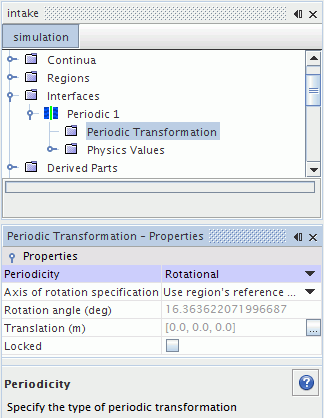Using the On-The-Fly FW-H Model with Rigid Body Motion
The FW-H Surface can have a rigid body motion, where it can be available for rotating motion as well as rotating and translating motion.
Using the On-The-Fly FW-H model with a rigid body motion (see [44], [46], [55]) involves actual displacement of mesh vertices in real time. The On-The-Fly FW-H model for rotating sliding mesh (a subset of rigid body motion) can be used in the prediction of noise from rotating blades as helicopter rotors and aircraft propellers.
For domains with rotational symmetry, you can model one sector of the domain using a periodic interface. The On-The-Fly FW-H model then reproduces noise sources for all sectors of the full domain. The model determines the number of sectors from the Rotation angle that you specify for the periodic transformation.
You can also use a repeating interface in addition to a periodic interface for a rotational sector model, such as for the simulation of rotor-stator interaction. When the sector represents less than 180 deg of the domain, snap-back occurs, which returns the mesh to its starting position once no matching is detected at the repeating interface. To avoid unphysical results due to the snap-back motion, be aware that in such a case the velocity field is not used for the FW-H acoustics calculation.
The periodic transformation must be purely rotational (that is, either Periodicity is set to Rotational, or Periodicity is set to Rotational+Translational with Translation equal to [0, 0, 0].)
The Axis of rotation specification property can use either the method Use region's reference axis or the method Specify axis.

The On-The-Fly FW-H model computes the sound pressure signal for all boundary zones of the FW-H surface, where each boundary zone can be part of a region with different number of sectors. You can use the model with periodic domains by selecting FW-H Impermeable, but only for three-dimensional simulations.